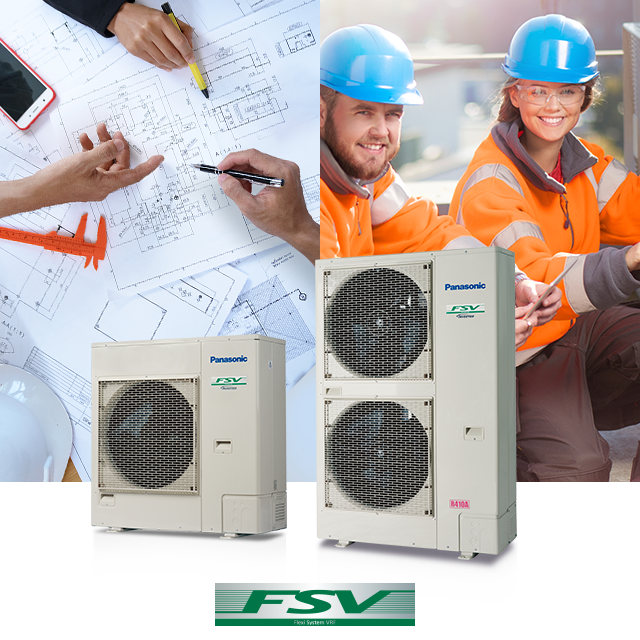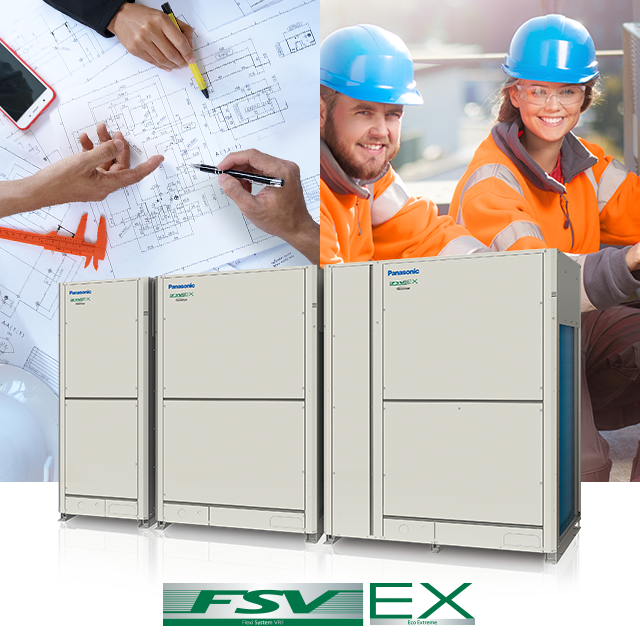
Advantages of the FSV Series
Technology that combines energy saving with air conditioning comfort
Panasonic’s FSV (Flexi System VRF) Series provides unique energy-saving functions to support the operation of sustainable air conditioning in a variety of business contexts, from offices to hotels and commercial facilities.
Intelligent 3-stage Oil Management System
To maintain reliability in VRF systems controlling many indoor units, securing enough compressor oil is essential. However, the standard method of forcibly operating to recover oil wastes energy and causes overheating or overcooling.
On the other hand, Panasonic FSV Series have oil level sensors in each compressor and can recover oil from other units to compensate for shortages. Thus, these systems provide comfortable environments while saving energy.
*Adapted Series: FSV-EX ME2
STAGE-1
Panasonic compressors are equipped with sensors which monitor oil levels precisely at all times. If oil levels fall, oil can be transferred from other compressors within the same outdoor unit.

STAGE-2
If oil levels in all compressors within the outdoor unit fall, oil can be replenished from adjacent outdoor units.

STAGE-3
Forced oil recovery is implemented only if oil levels become insufficient in spite of the above measures. The Panasonic system’s design concept is radically different from conventional oil systems.

Features of 3-stage oil recovery design

Oil sensors installed in each compressor
Oil sensors installed in each Panasonic compressor precisely monitor oil levels, eliminating unnecessary oil recovery.

Highly functional oil separator
Thanks to extended separate piping, oil recovery efficiency reaches 90%, minimising the oil to be discharged from the compressor.
Variable Evaporation Temperature (VET)
Since 2006, all Panasonic VRF systems have included special VET technology, with variable refrigerant temperature, as standard. Our ‘smart logic’ system checks the temperature every 30 seconds, automatically adjusting the refrigerant temperature according to actual demand and outdoor conditions.
*Adapted Series: FSV-EX ME2, Mini-FSV LE Series

Indoor Unit
Calculate indoor refrigerant temperature and control the airflow automatically based on the difference between the setting temperature and actual indoor temperature.
* When fan speed is Auto.
Outdoor Unit
Determine system refrigerant temperature and control compressor speed.
Achieves room-by-room comfort and overall system energy savings by controlling optimal refrigerant temperature and circulation volume based on all information of the entire system.
Outdoor Unit
The evaporation temperature information required for all indoor units in the system is consolidated for optimal refrigerant temperature control.
Indoor Unit
Based on the suction temperature, the amount of circulation refrigerant volume required for the cooling load is controlled by the expansion valve of each indoor unit.

Combination of VET technology and inverter compressor achieves both energy savings and comfort by smoothly controlling the compressor to match the air conditioning load without stopping the compressor for optimum performance.

Normal Environment
Room temperature changes are minimal, reducing power consumption with the Automatic Energy-saving Refrigerant Control.

Environment with Severe Cooling Load
If the set temperature is not reached after 25 minutes of operation in special environments with severe cooling loads, such as spaces with outside air entering, the system temporarily cancels energy-savingoriented operation and switches to air conditioning-oriented operation to achieve comfort as a priority. Returns to energy-saving operation after reaching the set temperature.


